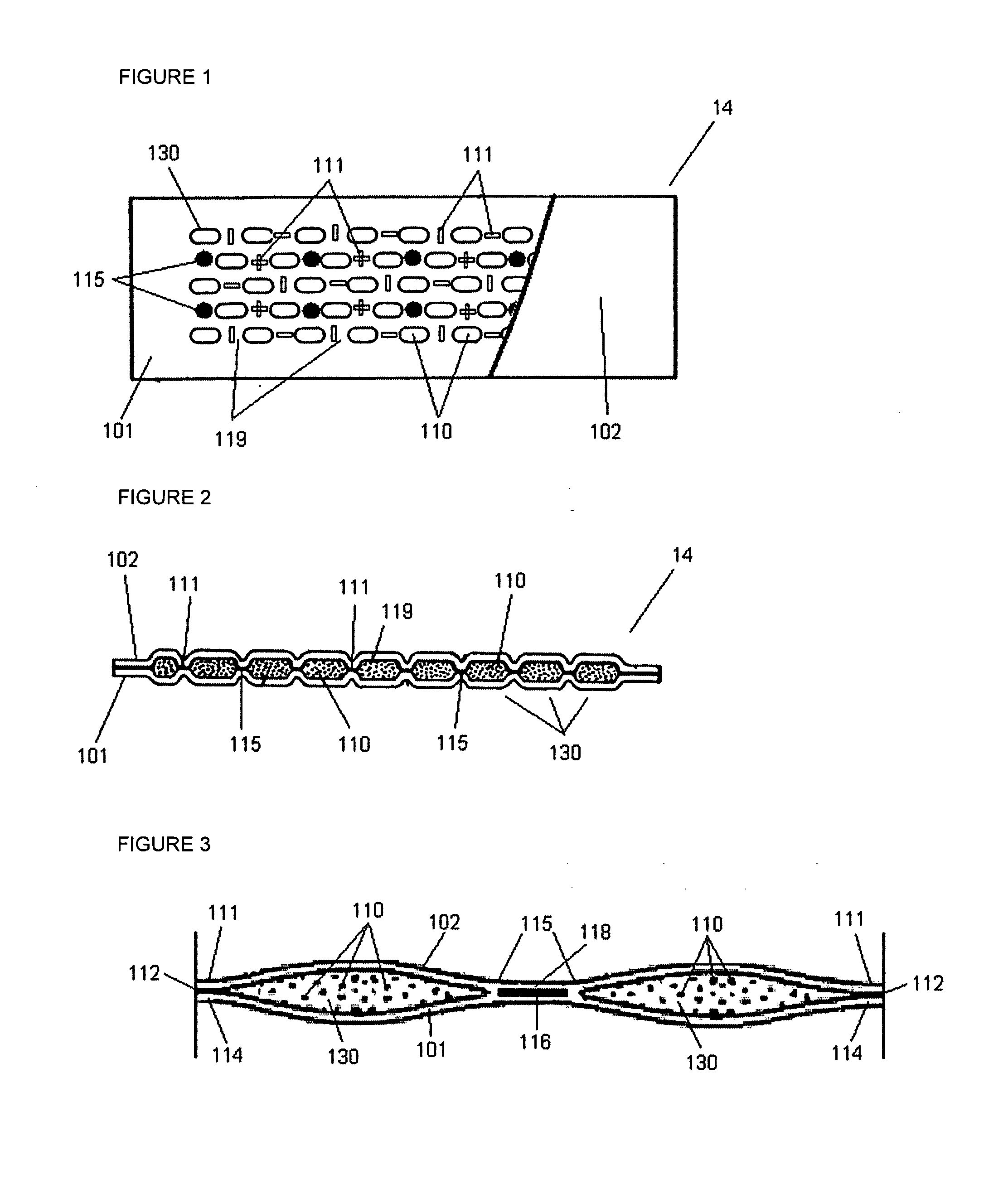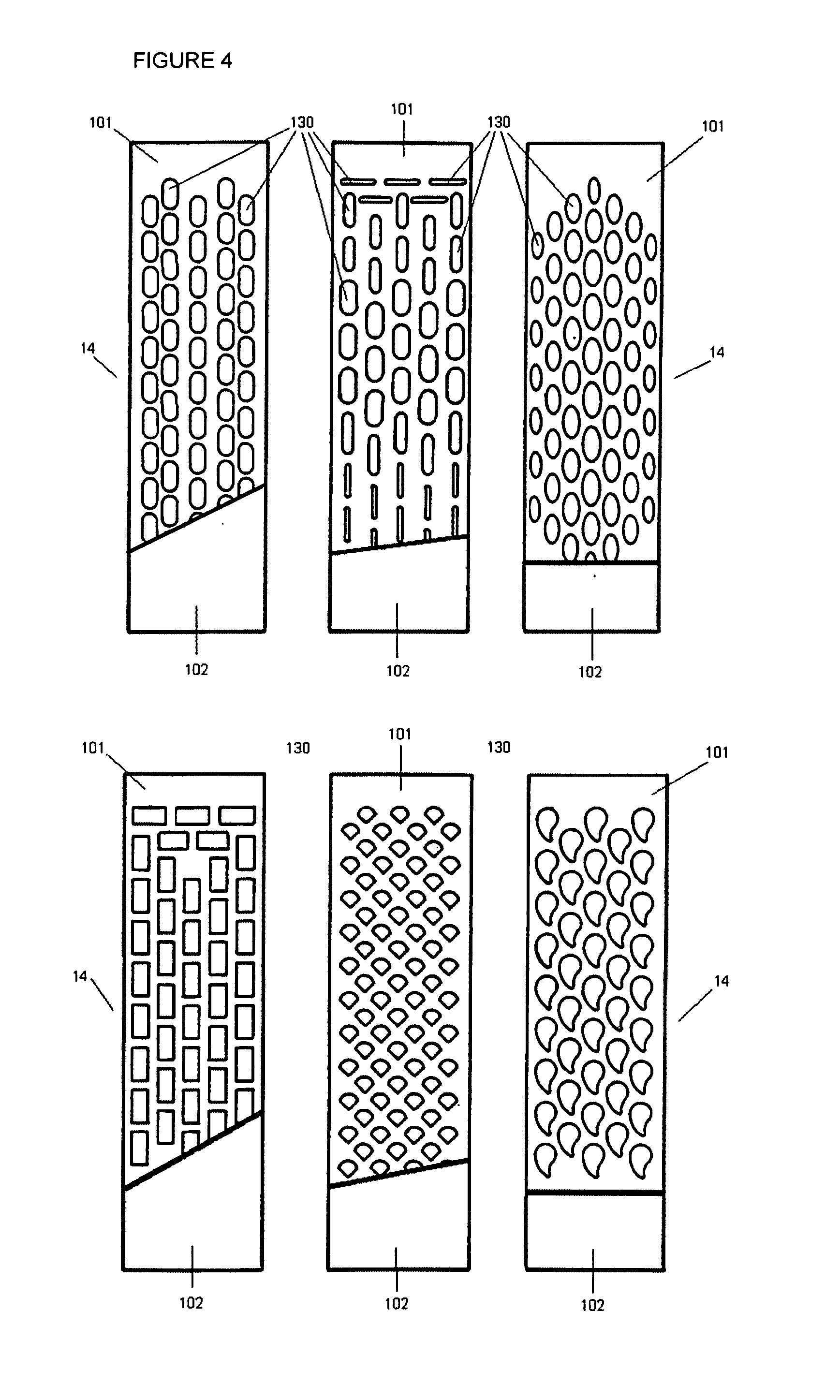However, since the presence of
cellulose fibers, usually wood pulp or fluff, results in relatively thick and bulky products, the process of manufacturing fluff involves
cutting down trees and treating the wood pulp with various chemicals and transportation of the raw materials and end product is typically done over relative large distances, the product and process is considered to be less
environmentally friendly.
However, the physical and / or
chemical interaction in between the
absorbent material and the bonding material and / or the
carrier material often leads to a reduced absorption, distribution and / or retention performance despite functional and / or structural requirements.
Failing to provide said sufficient
structural integrity results in loss of functional performance such as absorbent structure coherence, absorption and / or retention performance and partial or overall failure.
Moreover, it is equally important not to excessively
restrict the
absorbent material from expanding and / or swelling during the liquid uptake, as this would also have a negative
impact on the absorption and / or retention performance of the absorbent structure.
Hence, as to achieve good immobilization of the absorbent
polymer material according to the teaching of this patent relatively high amounts of
cellulose fibre material are required, thus increasing cost, bulkiness and rigidity of the absorbent article and severely reducing and hindering the expansion and / or
swelling capacity of the absorbent
polymer materials.
The provision of such pockets may also hinder the
free distribution of liquids to the more absorbent areas of the absorbent core, for example the areas of absorbent polymer materials.
While this construction certainly provides good immobilisation of the absorbent polymer material in the dry state, it seems that only a lesser immobilisation can be achieved in the liquid loaded state.
Therefore, in particular when the absorbent structure is to be used in an absorbent article to absorb and retain high amounts of bodily exudates, for example a diaper or pants, the absorbent structure disclosed herein may not be fully satisfactory.
However, due to the construction of the pockets, and specifically due to the selection of the water-sensitive attachment means, these pockets are not able to be controlled when the article is partially or fully loaded with liquids.
Therefore, it is believed that this absorbent article does not provide a satisfactory immobilization of the absorbent material in partially or fully liquid loaded state leading to functional /
structural failure.
However, in order to adequately secure the absorbent material, one needs to use a significant amount of
thermoplastic material, which leads to higher costs and more product rigidity.
Furthermore the high quantities of
thermoplastic material may often lead to shielding and / or blocking of the absorbent polymer materials leading to reduced absorption and retention performance.
Therefore, it is believed that this absorbent core does not provide satisfactory immobilization of absorbent materials in liquid loaded states.
Additionally, the use of
thermoplastic materials, glue or adhesives is considered to be less environmentally-friendly as they contain chemicals of a non-naturally renewable source and are based upon a complex chemical manufacturing process.
Whilst the above attempts describe various approaches to the above identified problems, it is believed that none of these absorbent structures leads to very performing absorbent articles.
For second, third and next liquid insults, these absorbent
layers may act as a liquid barrier due to the fact that these absorbent materials generally lose on liquid uptake and / or absorption capability once they are at least partially wetted and in a certain liquid expanded swollen states.
This results in slowing down and slowed down liquid absorption and distribution, which eventually leads to extra leakage.
The problem mentioned above typically arises in absorbent articles, such as disposable baby diapers, where the absorbent substance is an absorbent polymer material, which is excessively and substantially homogeneously and continuously distributed over a narrow
crotch width.
When absorbent polymer material concentrations are high and wetted, the hydro-gel can block the initial and / or additional fluid from reaching other more absorbent regions of the absorbent core, thus leading to unappreciated, underused and / or unused absorbent capacity.
The occurrence of gel blocking and hydro-gelling can lead to too slow or limited liquid uptake, distribution and / or retention resulting in leakage during usage of the absorbent article.
To remedy this problem, absorbent article designers have and typically use additional side cuffs, leakage barriers and / or acquisition and distribution
layers which are expensive, inefficient and can only partly remedy these problems and limitations.
 Login to View More
Login to View More 


